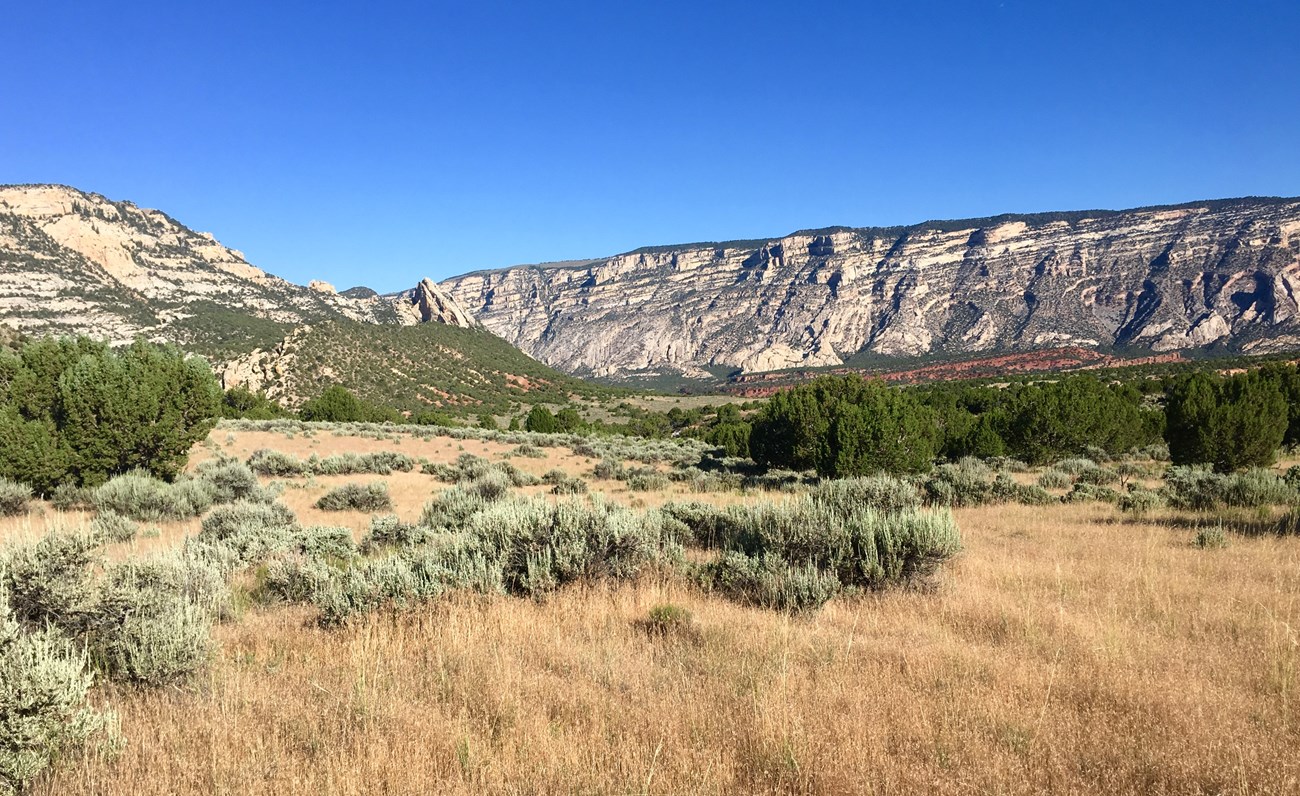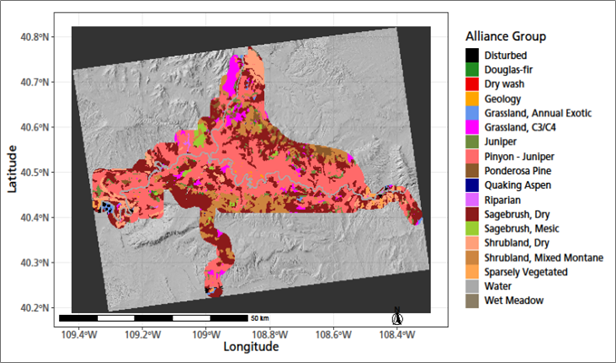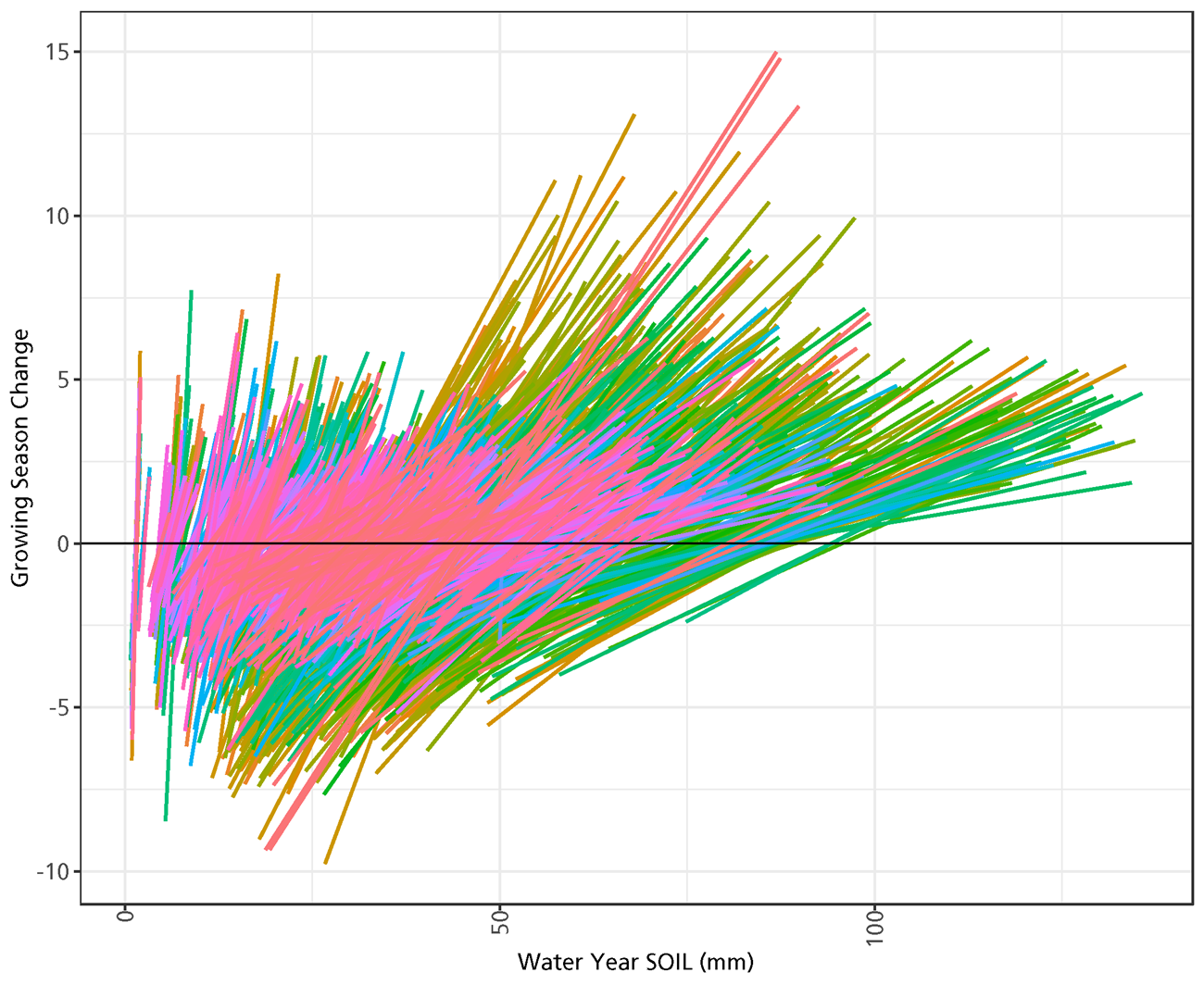Last updated: July 11, 2025
Article
Vegetation Production and Phenology at Dinosaur National Monument

NPS/Amy Washuta
What We Wanted to Know
At a Glance
- Growing-season production increased in all vegetation alliance groups between 2000 and 2019.
- Water, Wet Meadow, Disturbed, Dry Shrublands, and Annual Exotic Grassland alliance groups were the most drought-tolerant.
- Douglas-fir, Mixed Montane Shrublands and Mesic Sagebrush were the least drought-tolerant alliance groups.
- Changes in start and end of season resulted in a growing season 18.8 days longer.
Scientists with the Northern Colorado Plateau Network (NCPN) used two decades of satellite imagery and climate data to examine how vegetation at Dinosaur National Monument (NM) responds to weather and climate. The goal was to understand which vegetation types are most likely to change, where in the park those changes occur, and why, recognizing that not all vegetation responds to climate in the same way. In a semiarid region where precipitation is variable, vegetation response to long-term moisture patterns reveals which plant communities are resilient—and which are more likely to shift as the climate changes. The results offer a foundation for anticipating future change and preparing for shifts in vegetation composition and productivity.
What We Did
Researchers analyzed MODIS satellite imagery alongside daily climate data to evaluate long-term trends in vegetation productivity and the timing of growth (phenology) from 2000 to 2019. Using polygons mapped to 18 vegetation alliance groups, they assessed how vegetation production and phenology changed over time and how sensitive each group was to different aspects of climate (Figure 1.).

NPS/David Thoma
The study calculated “pivot points” (the value of a climate variable where vegetation teeters between below- and above-average condition) and “responses” (amount vegetation production changes in response to changes in a climate variable). These two measures of plant traits help characterize each vegetation group’s drought tolerance and climate sensitivity. And since climate can be evaluated in different ways, the study tested vegetation response to multiple variables, including precipitation, soil moisture, actual evapotranspiration, and water deficit.
What We Learned
Although the study began during a dry period, multiple indicators suggest growing season vegetation production increased at Dinosaur NM between 2000 and 2019. The largest increases occurred in Water, Disturbed and Annual Exotic Grassland alliance groups. Three years of soil moisture was the best indicator of growing season production across all alliance groups (Figure 2.).

NPS/David Thoma
Drought tolerance varied across the monument. Based on precipitation pivot points, Exotic Annual Grasslands, Dry Shrublands, and Dry Sagebrush were more drought-tolerant than the Juniper or Pinyon-Juniper woodland groups, likely due to seasonal growth traits and dormancy during the driest times of year. Forests generally respond more slowly to drought conditions due to deep roots and slower growth.
Phenology metrics revealed notable changes in the timing of growth. On average across all alliance groups, the growing season was starting 4.5 days earlier, the end of the growing season was occurring 14.9 days later, and it lasted 18.8 days longer on average than at the beginning of the study. An earlier start to the growing season was consistent across all alliance groups, while a later end occurred in all groups except C3/C4 Grassland and Dry Wash.
What We Recommend
Park managers can use the results of this study—and the tools developed from it—to interpret vegetation response in real time, anticipate future conditions, and inform both near-term decisions and long-term conservation goals:
Use pivot points to interpret current conditions: Real-time climate data—such as soil moisture, precipitation, or evapotranspiration—can be compared to vegetation-specific pivot points. This “now-cast” approach allows managers to estimate whether current-year vegetation production is likely to be above or below average (without the complexity of analyzing satellite imagery), helping guide timely decisions during drought or high-heat events.
Monitor high-sensitivity and high-response areas: Alliance groups such as Annual Exotic Grassland and Disturbed were among the most responsive to climate variables, meaning they may serve as early indicators of ecological shifts. Monitoring these areas can help managers anticipate change and prioritize adaptive actions.
Incorporate legacy effects in planning: Because vegetation production often reflects conditions from previous years, restoration planning and invasive-species strategies could factor in multi-year precipitation and soil moisture trends.
Prioritize high-value or sensitive areas: High value vegetation that is important as wildlife habitat, forage or even visitor enjoyment, such as picnic areas and campgrounds, may warrant higher management concern if it is very climate sensitive. Although climate sensitivity varied among alliance groups at Dinosaur NM, continued monitoring remains important to detect early signs of change in high-value or vulnerable vegetation types due to climate or other disturbance events.
Information in this article was summarized from Landscape phenology, vegetation condition, and relations with climate at Dinosaur National Monument, 2000–2019 by D. Thoma (2025). Content was edited and formatted for the web by E. Rendleman.
Tags
- dinosaur national monument
- disturbed
- douglas-fir
- dry wash
- geology
- grassland
- juniper
- pinyon juniper
- ponderosa pine
- quaking aspens
- riparian
- sagebrush
- shrubland
- sparsely vegetated
- wet meadow
- northern colorado plateau network
- ncpn
- inventory and monitoring division
- phenology monitoring
- phenology
- remote sensing
- vegetation monitoring
- long-term monitoring
- pinyon-juniper woodlands
- ponderosa pines
- monitoring
